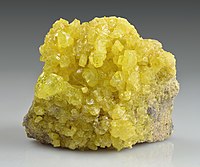
Photo from wikipedia
Abstract Rapid and accurate evaluation of sulfur-based pollutant contamination in an aqueous solution is one of the major tasks in environmental monitoring. A novel cyclodextrin phthalate ester polymer was used… Click to show full abstract
Abstract Rapid and accurate evaluation of sulfur-based pollutant contamination in an aqueous solution is one of the major tasks in environmental monitoring. A novel cyclodextrin phthalate ester polymer was used to synthesize gold and silver nanoparticles (NPs) with less than 15 nm size. The potential of the NPs solutions as chemosensor was assessed for the colourimetric detection of sulfur-based compounds. An agglomeration of only gold nanoparticles was induced selectively upon interaction with cysteine and sodium diethyldithiocarbamate (SDDC) leading to visual readout. The sensing, as well as quantification of cysteine (hydrophilic) and sodium diethyldithiocarbamate (SDDC) compounds (hydrophobic), occurred within seconds due to the dual binding ability of cyclodextrin. The limit of detection was determined using the linearity of absorbance plots. The proof of concept experiments demonstrates the rapid colourimetric determination in the range of 0.01–0.25 µM with a satisfactory limit of detection as 0.05 and 0.07 µM for SDDC and Cysteine respectively. The effect of pH and NaCl concentration on sensing was also investigated and optimized. 6 and 10 are the optimum pH values for the determination of cysteine and SDDC respectively. The optimum salt concentration was found to be 0.02 M for both the analytes. AuNPs nanosensor was much superior to AgNPs nanosensor as Au has an affinity for sulfur groups thus assisting a selective detection of cysteine and sulfur-containing pesticides in aqueous medium as well as allicin from onion and garlic extract.
Journal Title: Microchemical Journal
Year Published: 2021
Link to full text (if available)
Share on Social Media: Sign Up to like & get
recommendations!